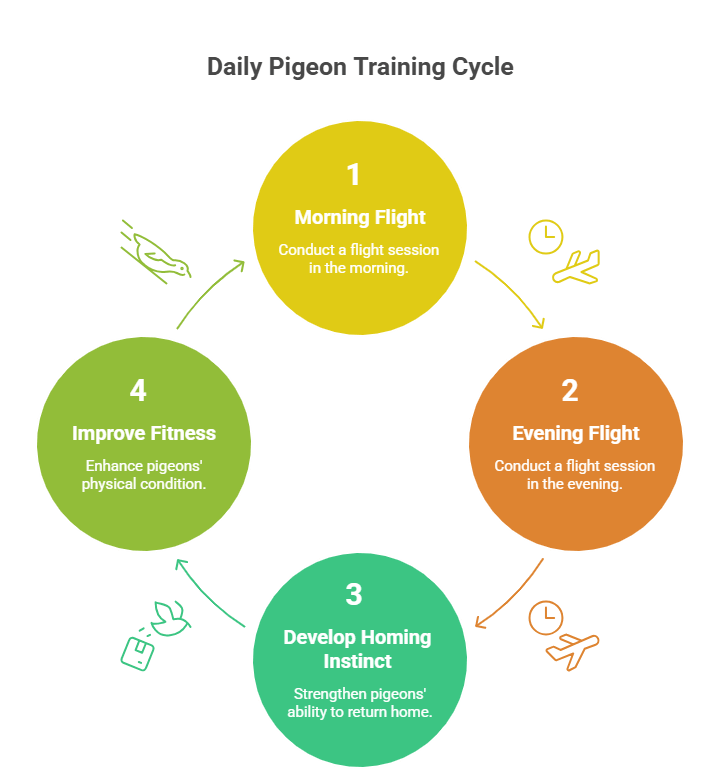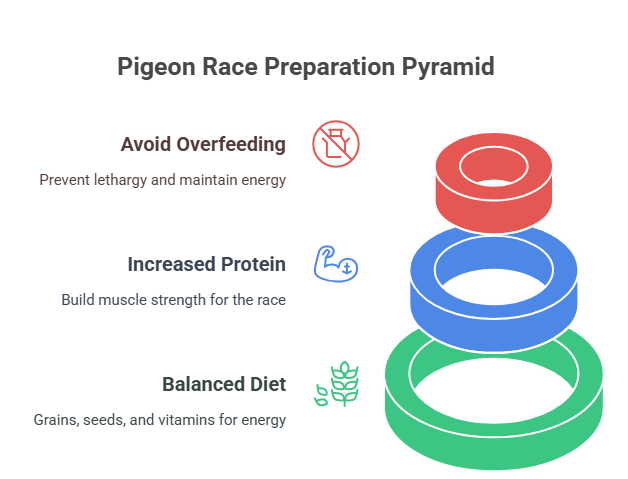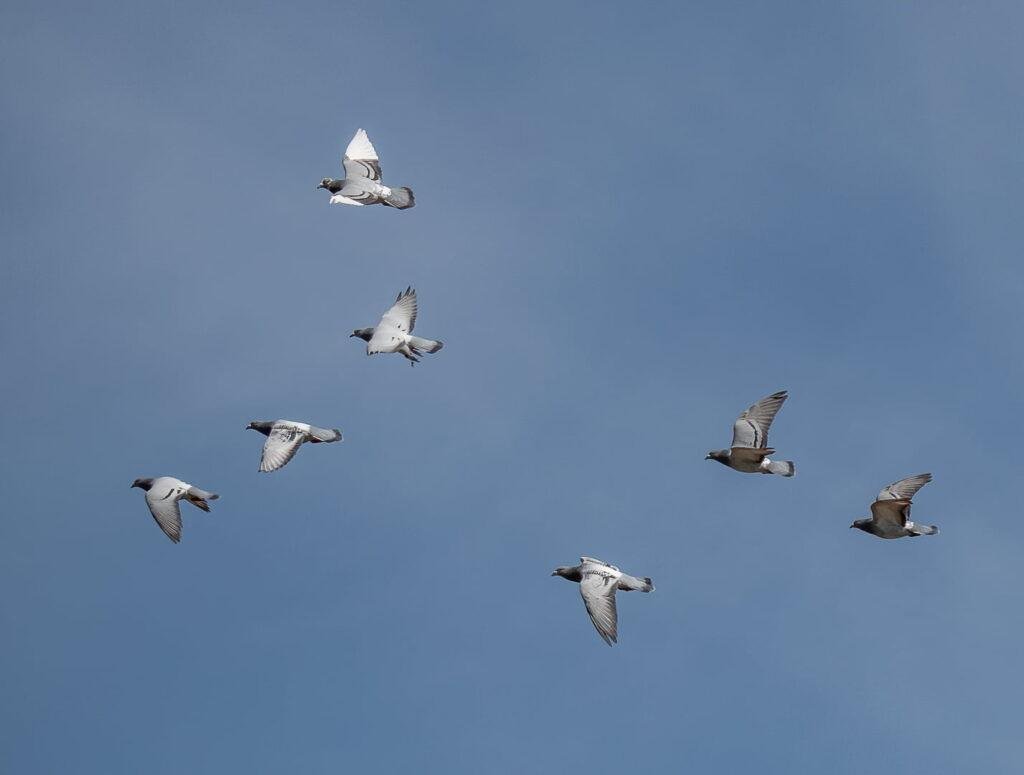Introduction to Racing Pigeons
Racing pigeons, also known as homing pigeons, are a special breed trained to return to their lofts over long distances, sometimes covering hundreds of miles. The concept of racing pigeons has a rich history, with roots tracing back to ancient civilizations that utilized these birds for communication. Today, pigeon racing is a competitive sport that blends tradition with modern training techniques.
Young racing pigeons, often referred to as “squeakers” or “young birds,” are particularly pivotal in the sport. Training these young pigeons is crucial as it lays the foundation for their future success in races. The most common breeds used for pigeon racing include the Belgian and Dutch varieties, known for their endurance, speed, and homing instincts.

Training young racing pigeons from an early age is essential for several reasons. Firstly, it helps them develop their homing ability, ensuring they can navigate back to their loft even from unfamiliar locations. Secondly, early training enhances their physical fitness, crucial for the demanding nature of races. Moreover, young pigeons that undergo a structured training regimen tend to be more disciplined and resilient, able to withstand the rigors of competitive racing.
Starting the training process early has several benefits. It allows trainers to gradually introduce young birds to various aspects of racing, such as loft flying, route familiarization, and endurance building. This gradual introduction helps prevent stress and ensures that the birds are well-prepared for the challenges ahead. Additionally, early training fosters a strong bond between the pigeons and their trainers, which is vital for effective communication and successful race strategies.
This introductory section sets the stage for a comprehensive exploration of young racing pigeon training tips, from loft flying to race day. Understanding the fundamentals of pigeon racing and the importance of early training will provide a solid foundation for the detailed training regimen that follows.
Loft Flying: Building the Foundation
Loft flying serves as the cornerstone of any young racing pigeon’s training regimen. The initial focus is on acclimating the pigeons to their loft, which they need to recognize and accept as their home. This is crucial for their sense of security and spatial orientation. Begin by confining the birds to the loft for a few days, allowing them to familiarize themselves with the interior environment, feeding areas, and perches.

To encourage regular loft flying, establish a consistent feeding schedule. Feeding should occur at the same times each day to create a routine that the pigeons can rely on. Placing feed inside the loft also serves as a motivator for them to return after their flights. Additionally, using traps at the loft entrances can help young pigeons learn to navigate in and out efficiently. Initially, leave the traps open to allow free movement, and gradually transition to using the trap mechanism to guide their entry.
Regular loft flying is essential for the muscle development and overall health of young racing pigeons. It provides them with the opportunity to exercise their wings and build the stamina required for longer flights. Moreover, loft flying enhances their navigation skills, enabling them to become adept at recognizing landmarks and spatial cues around their home base.
Managing loft conditions is another critical aspect of optimizing training. Ensure that the loft is well-ventilated and clean to promote the pigeons’ respiratory health. Adequate space should be provided to prevent overcrowding, which can lead to stress and aggressive behavior. Additionally, maintaining a calm and quiet environment helps in reducing anxiety and encourages the pigeons to stay focused during their training sessions.
By diligently following these young racing pigeon training tips, you lay a strong foundation for your pigeons’ future success on race day. Consistency, patience, and attention to detail during the loft flying stage are key components in developing well-trained and healthy racing pigeons.
Transitioning to Road Training
Transitioning young racing pigeons from loft flying to road training is a critical step in their development. This phase involves gradually introducing them to short-distance releases and progressively increasing the distance to build their endurance, enhance their homing instincts, and boost their confidence. Initially, start with releases just a mile or two away from the loft. Consistent short-distance training helps the pigeons familiarize themselves with the process of being transported and released in unfamiliar locations.
As the pigeons become more comfortable, incrementally increase the distance of the releases. For example, extend it to five miles, then ten, and so on. The key is to ensure that each increase in distance is manageable for the young birds, preventing them from becoming disoriented or overly fatigued. It’s beneficial to maintain a consistent training schedule, as regular routines help the pigeons develop a strong homing instinct and build their physical stamina.

Monitoring progress during road training is essential. Utilizing tracking devices can provide valuable insights into the pigeons’ flight paths, speed, and overall performance. These devices can help identify any issues, such as birds that struggle to navigate or return promptly. Addressing these issues early on can prevent larger problems during actual races.
Common challenges during road training include adverse weather conditions, predators, and the pigeons’ natural learning curve. To mitigate these challenges, choose training days with favorable weather forecasts and be vigilant about potential threats. Gradual exposure to varying distances also helps the young birds adapt without becoming overwhelmed.
Consistent and well-structured road training is crucial for developing successful racing pigeons. By progressively increasing distances, maintaining a steady training routine, and closely monitoring their progress, young pigeons can gain the endurance and confidence needed for race day. These young racing pigeon training tips can significantly enhance their preparedness and overall performance, setting the foundation for a successful racing career.
Preparing for Race Day
When it comes to preparing young racing pigeons for race day, meticulous attention to detail is paramount. A well-structured pre-race routine can significantly impact their performance. Key aspects of this routine include diet, rest, and thorough health checks.
Starting with diet, it is crucial to ensure that young racing pigeons receive a balanced and nutrient-rich diet in the lead-up to the race. High-energy foods, such as grains and seeds, should be included to provide the necessary stamina for the race. Additionally, incorporating supplements like vitamins and minerals can further enhance their physical condition. Hydration is equally important; ensuring access to clean, fresh water at all times is essential.
Rest is another critical component of pre-race preparation. Adequate rest allows pigeons to recuperate and build the energy reserves needed for race day. Creating a calm and stress-free environment in the loft can aid in this process. Minimizing disturbances and ensuring the loft is a quiet sanctuary will help the birds relax and rest adequately.
Regular health checks are indispensable to maintain the pigeons in peak condition. Monitoring for any signs of illness or discomfort and addressing these issues promptly can prevent last-minute setbacks. Consulting a veterinarian for a health check-up before the race can provide peace of mind and ensure the birds are in optimal health.
On race day, handling the pigeons with care is crucial. During transportation to the release points, it is essential to keep them comfortable and minimize stress. Ensuring the carrier is well-ventilated and not overcrowded can help maintain their well-being. Upon arrival, giving the pigeons some time to acclimate before release can further enhance their race performance.
Post-race care is equally important. After the race, allowing the pigeons to rest and recover is vital for their long-term health and future races. Providing a nutrient-rich recovery diet and plenty of hydration will help them regain their strength. Monitoring their health in the days following the race can also prevent any potential issues from arising.

